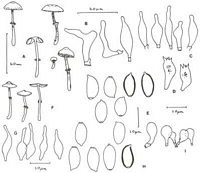|
 Conocybe vexans Conocybe vexans
BiostatusOccurrence uncertain
Images (click to enlarge)
Caption: A-E Horak 69/20, A. Basidiomata with section; B. Caulocystidia; C. Cheilocystidia; D. Basidia; E. Basidiospores. F-l Horak 68/440, F. Basidiomata; G. Cheilocystidia; H. Basidiospores; I. Pileipellis. |
Article: Watling, R.; Taylor, G.M. (1987). Observations on the Bolbitiaceae: 27. Preliminary account of the Bolbitiaceae of New Zealand. Bibliotheca Mycologica 117: 61 p. + 17 pl.
Description: Pileus 17-24 mm, hemispherical becoming convex to subcampanulate, brown, turning yellow-brown with age, strongly hygrophanous, smooth, membranaceous, dry, margin striate. Gills adnexed-adnate, ventricose dense, pale (whitish), turning rust brown, with minutely dentate white edge. Stipe 32.5-37 x 1.5-2 mm (base < 3 mm), ±cylindric, annulate, apex pruinose, pale yellow to white, below ring longitudinally fibrillose or minutely squamulose, base dark brown, dry, hollow, fragile, ring mobile, whitish, striate-grooved smooth beneath, persistent. Smell none.
Basidiospores 10.5-12.5 x 6-6.5 µm, elliptic in face-view slightly flattened in side-view, thick-walled, ochraceous brown in water, slightly darker in aqueous alkali solutions, non-amyloid; germ-pore central, broad. Basidia 4-spored, clavate with short pedicel, hyaline in water and alkali solutions, 27.5-35 x 10-12.5 µm. Cheilocystidia ampulliform to cucurbitiform or lageniform 30-35 x 7.5-12 µm, with distinct neck 7.5-15 x 2.5-3.5 µm, hyaline in water and alkali solutions; pleurocystidia absent. Pileipellis a strict palisadoderm of smooth, spheropedunculate cells 10-26 x 14-22 µm; pilocystidia absent. Stipitipellis of cylindric, hyaline, parallel hyphae, above the ring supporting groups of irregularly lageniform caulocystidia 35-42 x 8-12 µm with apex 3-4 µm, below ring with floccose hyphae. Clamp-connections present.
Notes: This collection differs from C. vexans in its habitat preference; it is unknown on dung in Europe. Two coprophilous, annulate Conocybe spp. (sg. Pholiotina), occur in North America but they differ in their microscopic characters particularly the smaller basidiospores. C. vexans is the same as Kuhner’s four-spored form of C. blattaria; see Walling & Gregory (1981) and van Waveren (1970).
A second collection, Horak, in ZT 68/440 probably represents the same taxon although the pileus was wrinkled at the centre. We do not place much emphasis on this phenomenon which is not infrequent in many members of the Bolbitiaceae; compare C. rugosa and C. filaris in Walling (1982). This collection, from under Leptospermum ericoides A. Rich., Wharariki, Cape Farewell, Nelson, 13 v 1968, has both slightly narrower, and therefore slightly fusoid spores and narrower cheilocystidia; the following description is offered:
Pileus 14-17 mm, umbonate-convex to campanulate, dark ochre-brown (wet), ochraceous (dry), hygrophanous, micaceous-shiny, at least centre wrinkled-venose, dry, striate; veil remnants absent. Gills adnate to adnexed, ventricose, pale ochre (young), chocolate brown (with rust brown tinge) when old, crowded, with white, fimbriate edge. Stipe 25-34 x 1-1.5 mm (base 2 mm) cylindrical or subclavate, annulate, concolorous with pileus, subpruinose at apex, fibrillose towards base, hollow, dry; ring persistent, striate-grooved, immobile. Smell and taste not distinctive.
Basidiospores 10-12.5 x 5.5-6.5 µm, ellipsoid in face-view, slightly flattened in side-view, thick-walled, ochraceous brown in water, slightly darker in aqueous alkali solutions, nonamyloid; germ-pore central, broad. Basidia 4-spored, 24-25 x 5-9 µm. Cheilocystidia ampulliform to cucurbitiform with distinct elongate neck, 30-37 x 8-11 µm with apex 2 µm broad. Pileipellis a palisadoderm of pedicellate cells, 22-40 x 12-22 µm.
|